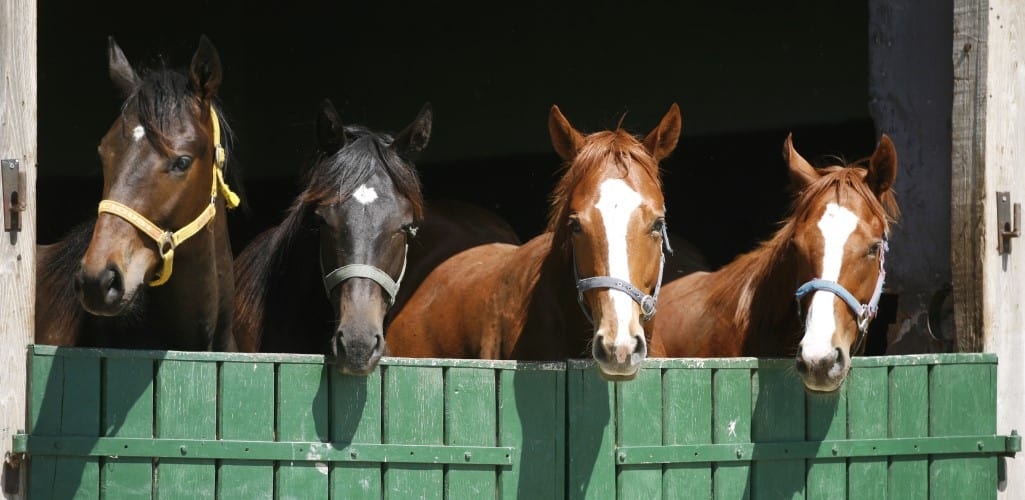

Reading your horse’s body language
Do you understand what your horse is telling you with their body language? Are you an expert at interpreting every little flick of their tail or stamp of a hoof?
It’s incredibly useful to be able to read your horse’s body language. Here we look at how horses use their bodies to communicate and how you can pick up on what they are feeling.
How horses communicate
 Horses are highly social animals. They’re used to living together in herds and it’s important to them to be able to communicate with others in their family. For horses in the wild, their ability to survive depends on this, from gaining the protection of the herd to finding food and shelter.
Horses are highly social animals. They’re used to living together in herds and it’s important to them to be able to communicate with others in their family. For horses in the wild, their ability to survive depends on this, from gaining the protection of the herd to finding food and shelter.
Horses communicate vocally both between themselves and with us, by whinnying, nickering, snorting, blowing and squealing. However, they tend to tell us a lot more with their body language than with the sounds they make. This is probably because horses that live in close-knit herds can usually see each other, so are likely to spot the tell-tale physical signs that communicate how they’re feeling.
The benefits of learning equine body language

You can gather so many important clues about your horse’s mood from their body language.
“By reading your horse’s body language, you will know how your horse is feeling. And if you know how your horse is feeling, you can act accordingly,” says Kathryn Hall, a member of the YuMOVE veterinary team who also provides equine physiotherapy through her business, Animotion.
“By noticing subtle changes in your horse’s body language, you can get a good idea if your horse is happy, relaxed, angry or in pain. If, for example, your horse is in pain, you can then make sure you get them some help.”
How is your horse feeling?
Here, Kathryn gives her tips on how to spot how your horse is feeling by reading their body language.
1. Signs that your horse feels unwell
“If your horse is feeling unwell, they may change their behaviour, guard themselves and act aggressively. You might notice that their muscles are tense, they are pawing the ground or are constantly shuffling their weight from one leg to another.”
“They may be girthy when you’re tacking up. Or, when they’re being ridden, your horse may swish their tail excessively, toss their head, open their mouth a lot and have their ears back consistently. A high neck carriage can be another sign of sickness, especially if your horse has their ears back, a hollow back or is wringing their tail.”
2. Signs your horse is happy

“If your horse is happy and enjoying what you’re doing together, you’re likely to notice that their ears are forward, their body is relaxed and they are behaving well. They will let you do what you want, whereas a horse that is unhappy will be lot more reluctant to go along with what you want to do.”
“A raised tail can mean that your horse is happy and excited. We often see horses with raised tails when they are playing with their friends in the field.”
3. Signs your horse is relaxed
“You can tell that your horse is relaxed if their ears are forward or out to the sides, they’re resting a leg or closing their eyes. A floppy lip, slow breathing and low head carriage are other signs that your horse is feeling calm and comfortable. Another interesting bit of body language is chewing: this shows that your horse is relaxed and thinking.”
4. Signs your horse is nervous
“If your horse is nervous, their body language will be agitated. They might twitch, flare their nostrils and be unable to stand still.”
“Rapid ear and eye movement is often a sign that your horse feels there is too much going on around them, or they’re trying to locate a sound or smell, or looking for a way to escape. If you notice this kind of body language, it could well be a signal that your horse is feeling anxious.”
“Other signs of nervousness include a tight muzzle and mouth, tightness in the muscles around the eyes, the tail pinned down in between their legs, trembling and excessive defecation.”
5. Signs your horse is annoyed

“If your horse is annoyed, they may be agitated, twitchy and unable to stand still. They might also try to bite or kick you. When stallions are fighting, you might see them moving their heads from side to side in a low head carriage, which is another sign of aggression.”
“Pawing the ground can be a sign that your horse is impatient or bored. However, it can also be a sign of stress. If your horse stomps their front leg, look out, because they’re not happy. They might even be about to kick out. Kicking a back hoof or raising a hind leg is also often a warning for you to back off.”
“If a horse is swishing their tail from side to side to get rid of flies, you don’t need to interpret that body language as a sign of irritation. However, if this is a rapid movement, your horse might be letting you know that something has got on their nerves.”
Body language and bonding
Thanks so much to Kathryn for sharing these super-helpful tips. Of course, every horse is individual, and you’ll know better than anyone what your horse is trying to tell you with their body language.
But the more you know about how to interpret their body language, the better the bond between you and your horse. You’ll gain their trust, deepen the respect that they have for you and be able to make the most of the time that you spend together.
What do you think?
What have you noticed about your horse’s body language? Do you have any tips to share? Please share your thoughts and photos on our Facebook and Instagram pages.



